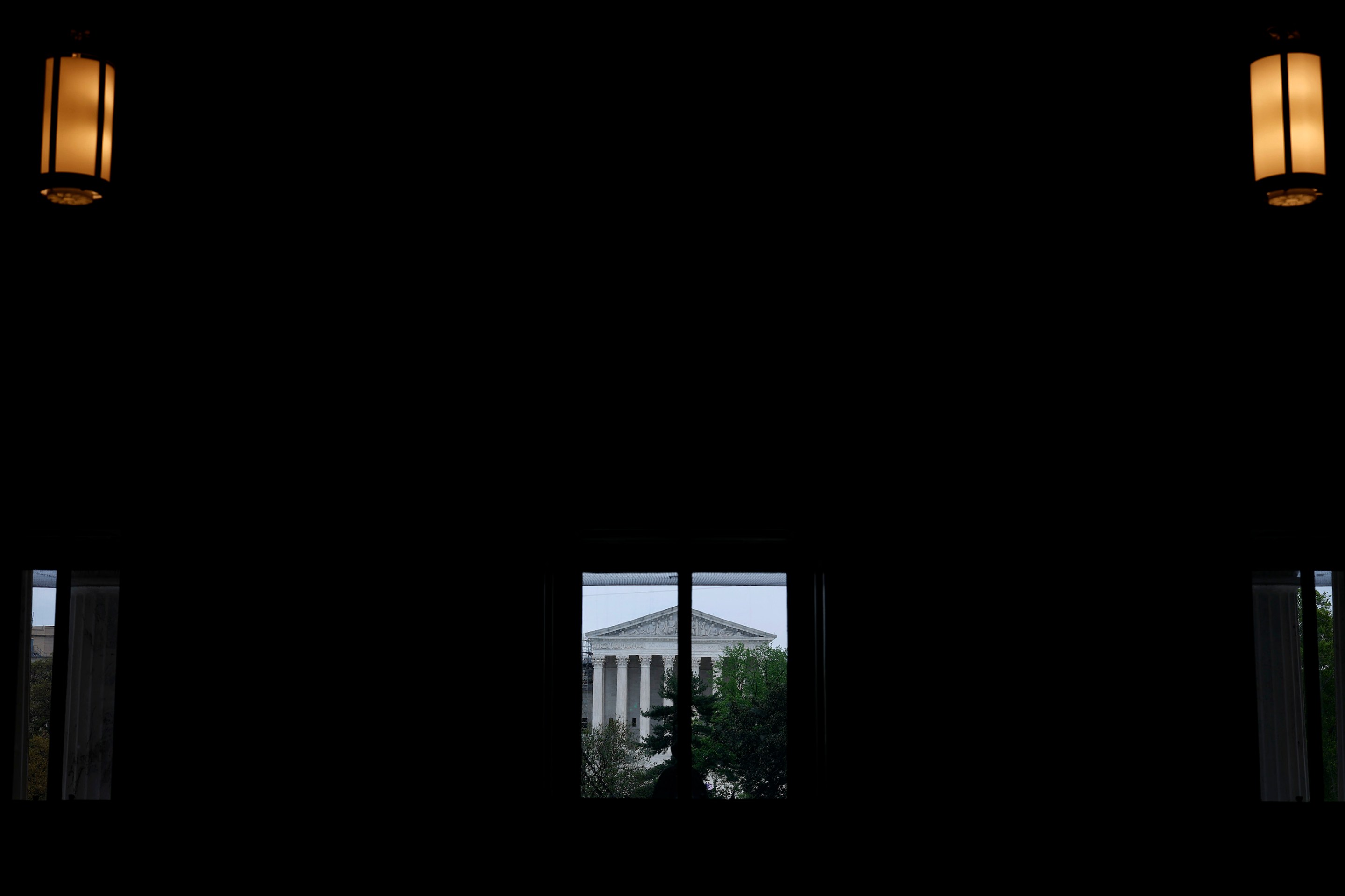Virtually every benefit that the people who paid to attend Trump University received was intangible. This is true to some extent for everyone who spent time at college but more literally true in this case because the benefits otherwise didn't exist. The scammy continuing-education gambit, which operated between 2005 and 2010 and to which the future president licensed his name and rictus, was a prototypical Trump endeavor. People ignorant or naive enough to confuse his gilded brand with actual merit were subjected to relentlessly aggro high-pressure salesmanship from the school's representatives; they paid between $1,495 and $35,000 to learn the importance of Thinking Like A Winner. "Attendees were told to use the real estate website Trulia.com to find properties," NPR wrote in 2016, "or to go to the website of the Internal Revenue Service, irs.gov, to learn about federal tax deductions." Trump settled a class action lawsuit filed by the school's former students for $25 million, or something like 80 to 90 percent of what they'd paid for the programs, in 2018.
But there was one prescient and undeniably tangible benefit for Trump University students. It was not meeting Donald Trump himself; as John Cassidy wrote in The New Yorker, "the closest that the attendees at the seminars got to Trump was when they were encouraged to have their picture taken with a life-size photo of him." In that aspect, and that aspect only, Trump University students received something absolutely at the leading edge. As Trump ascended to the presidency, and then after he declined into his present babbling and ominous permanence, images of a grinning Trump alongside various people—criminals and supplicants and showbiz dingleberries, taut-faced realtors and glazed Mar-a-Lago wedding guests and people with "UFC vibes"—became a sort of cultural currency. It is still in circulation.
It is not a valuable currency, exactly, but it's recognized. As a general rule everyone in these pictures looks bad. Trump's own visual uncanniness has a powerful halo effect, and the photos are taken in places with peculiar lighting: golf clubhouses, MMA events, rich people's third weddings. To see this sort of picture is to be reminded of how it felt when this type of vain, vicious, unappeasable goon squatted plump and boastful over the broader culture.
Legends @ufc pic.twitter.com/6hDLUXQ8KN
— Donald Trump Jr. (@DonaldJTrumpJr) April 9, 2023
If these images are unpleasant to behold, it's partially because of what they reveal. The aesthetics of various strains of reactionary politics are by now easy enough to parse re: what they seek to project, and why. The leather-and-chrome theatricality of fascism is first and foremost a tell—a coalition of vengeful and embittered nullities and their ruddy bosses expressing a repressive, aggrieved, fundamentally bourgeois political impulse, dressed up as a confident expression of natural dominance. The same goes for the ongoing effort to sell the dustiest loathsomenesses as somehow transgressive and countercultural; it's telling in what it reveals about how value-neutral conservatives actually are—"you guys like offensive stuff, right?"—but mostly funny in positing that the boldest and most punk worldview imaginable is that of a dull suburban bigot in 1971. The not entirely outmoded preppy/establishment style of American conservatism is just as transparent, in its way. This is a movement that knows it has no real tradition presenting itself as dignified and ancient, instead of just the marriage of the worst American ideas and some secondhand marketing.
The endless trove of Trump thumbs-up pics is by comparison much closer to an accurate representation of who was in charge when Trump was in power, and offers a truer sense of what they celebrate and how. It's still ugly, but it is at least what it looks like: an endless reception at which drop-shipping sociopaths and epic landlords and extremely powerful financial criminals and their awful adult children and a great many people who previously considered themselves above this sort of thing before realizing they were not—that is, every unremarkable mini-tyrant currently making civic life more degrading and extractive wherever possible—toast and toast and toast each other's successes, and try to fuck each others' wives.
It all feels and certainly looks like the end of something, but some different images have emerged that made me reconsider my sense that those thumbs-up pics were an apotheosis. If those images were a depiction of what Trumpism is fundamentally about, the conservative movement currently shrinking and demeaning American politics looks very different. As Republican elected officials follow their leader into strident kookery and clammy influencer-style grifting, the movement's work is increasingly done through the courts, by judges that Trump and those otherwise unmanageable goofs gave lifetime appointments.
Those judges are the product of a farm system designed and funded by a few conservative elites, and are incubated and promoted through a sprawling network of patronage that's a social network and political class unto itself. That process is designed to exploit both the antiquities of the American political system and the weaknesses of its political discourse. It does the first by slotting these hothouse-grown goons, many of whom have barely practiced law before assuming their lifelong appointments and all of whom are there because they can be counted on to issue rulings that advance movement goals, into jobs from which they cannot be fired. The discourse hack is subtler, and amounts to norm-abuse—the bipartisan insistence that both the institutions being busted-out and co-opted and the individual mediocrities doing that work should be treated with reverence, because of how important those institutions and jobs are.
It cannot be overstated how much this gambit depends upon the billionaires funding it; there is not a popular movement for very many of these ideas. The system works to ensure that the people funding it and their interests are never offended or inconvenienced; a priestly caste of political elites acts as the intermediary between the rich people and the systems that protect and flatter them. This is all happening right where everyone can see it, and the organizations that comprise that system—the Federalist Society, or Alliance Defending Freedom—are themselves well known by now. The billionaires propping it up are seen mostly in the negative, through which otherwise unsaleable candidates and policies rise in response to their personal quirks and irks. It is difficult to write about all this without sounding like someone who is speaking increasingly and dismayingly quickly. Thankfully, the last weeks have given us an image that illustrates it better than it can be described.
2019 oil painting "by Sharif Tarabay for Mr. Harlan Crow out of Dallas. Just 5 Friends discussing the law. Those five friends happen to be Justice Clarence Thomas, Mr. Bo Rutledge, Mr. Mark Paoletta, Mr. Leonard Leo and Mr. Harlan Crow." https://t.co/z6Kue3OF3S pic.twitter.com/p9w1NStpOJ
— Travis Nichols (@travisjnichols) March 24, 2022
Among the many infuriating and bleakly hilarious details in the blockbuster ProPublica story about the relationship between conservative billionaire and political donor Harlan Crow and Supreme Court Justice Clarence Thomas was the fact that Crow commissioned an oil painting of himself, and Thomas, and the head of the Federalist Society, and a law school dean, and a former Trump administration official, enjoying cigars together on his patio. That painting was less eye-catching than the news that Crow also has a jarringly vast collection of Hitler memorabilia in his home, and a Garden Of Evil that he's stuffed full of statues of various dictators—but notably not Hitler, whose paintings (which Crow also owns, also quite normally) are displayed elsewhere, near his Monet. As with the oil painting of Crow and the lads, those communist dictator statues are not notable as art; they have the same shoddy Chocolate Easter Bunny look as the dorky mass-produced Confederate memorial statues that have come down in American cities since 2020. But they are fascinating as oafish monuments to Crow's fatuously politicized bad taste.
The “Garden of Evil” dictator statue garden at the Harlan Crow Library. pic.twitter.com/5zpZpfOQoC
— PatriotTakes 🇺🇸 (@patriottakes) April 8, 2023
The conversation sparked by that ProPublica story went about how you'd expect, with conservative commentators alternating between hissing I guess it's illegal to have friends now and getting offended at the conclusions that people jumped to about Crow's remarkable collection of Naziana. It turned inward, as such conversations do, and probably bottomed out when Graeme Wood, in The Atlantic, wrote "What is it about Nazism that makes these people lose all reason and sense of proportion? I guess it’s the industrial slaughter of Jews, Gypsies, people with disabilities, and homosexuals, and the nearly successful attempt to conquer the planet. So I can see why someone might freak out over Hitler memorabilia," and then started his next sentence with the word But.
The question of whether a born-rich real estate billionaire does or doesn't venerate Hitler is not a very interesting one, but how quickly it became the central question seems significant. It was delightful to watch one conservative elite after another step forward and fulsomely defend Crow as a decent and kind man (who, full disclosure, has also made their otherwise untenable careers possible). It was also bleakly funny to see affectively liberal doofuses like Wood try to stake a moderate position on the question of The Billionaire's Vast Personal Collection Of Nazi Shit. But it seemed telling that what was most disturbing about the story so quickly became secondary to the question of whether one dull conservative billionaire was or wasn't nice. What the ProPublica story made clear, and which a follow-up story revealing that Crow bought and then renovated the house in which Clarence Thomas's mother lives made explicit, is how this network of conservative elites actually works—not through discreet acts of bribery, but as a self-enclosed network of influence and relationships that exists above any kind of accountability. It is a hierarchical and exclusive community, not a series of individual actions.
That is a point that our political media, which is generally agnostic on whether elite-driven systemic forces even exist, is built to miss. Crow, for his part, has defended his expensive and long-running sponsorship of Thomas and his wife by saying that they are his dear friends; the way conservative elites took up his defense suggests that, while they all clearly see him as a current or future benefactor, they found it more tasteful to think of him as a buddy than as an ATM they sometimes visit. It was a snapshot of how small and shabby this whole scene is. There are thinkers who fall somewhere between mediocre and actively vile, whose business is telling a few rich dullards what they want to hear, and then there are the rich dullards paying for it all. All of them are invested in believing that inherently transactional relationship is actually a movement.
Harlan Crow surely has enemies but, as far as I can tell, they consist exclusively of people who don't know him. Everyone who does know him may disagree with him on some issue, but they universally recognize his decency, integrity, and kindness. Including people of the left. https://t.co/OZV2rKdCO6
— Charles Murray (@charlesmurray) April 8, 2023
It is hard to know what to do with this. It is good, I guess, that people know what the conservative movement is, but that doesn't help with the necessary work of stopping it from taking everything it can from everyone outside its circle of service or protection. It's also bracing to know there isn't really some secret, respectable, intellectually honest and compelling version of conservative politics to which these elites have access; we can't know what Crow and Leo and Thomas were talking about in that garden, but all available evidence suggests that it's the same salty, high-fat dogfood that cable news casualties choke down.
But knowing that this is all more or less a fraud—ideas without much merit or constituency, advanced by people whose sole distinguishing attribute is their shamelessness on behalf of people whose sole distinguishing attribute is their wealth—is just a start. That this is all being done through the perverse and cynical instrumentalization of political institutions lands as a taunt; the mechanisms that children are taught exist to prevent this sort of tyranny are instead used to facilitate it. The challenge is to think bigger, or just differently, about how to remain or become free.
I think this is why I have kept returning to Crow's terrible paintings of himself with his friends. They were painted by an artist named Sharif Tarabay, who lives in Montreal and is represented by a creative agency in Connecticut. Tarabay is an artist making a living, and the portfolio on his website reflects this. There is the portrait of Steve Coogan that he drew for the defunct lad mag Nuts, and a Christmas card featuring the stars of Ryan Murphy's "Glee," and a painting of a lingerie-clad Kate Middleton for The Daily Mirror, and a painting of an angel in a three-piece suit watching a young child enjoy an old-time ice cream sundae. There are also all those paintings of Harlan Crow in a golf shirt chopping it up with various Republican eminences. It's all very clearly work for hire; if there are any palpable politics in Tarabay's work, it's in the latent signifiers attached to the artist's obvious affection for Norman Rockwell. Rockwell's iconic Saturday Evening Post covers, the aesthetics of which are to this day enlisted to wildly divergent political ends, were work for hire, too.
The paintings that Tarabay did for Crow are definitionally kitsch—wildly banal in form, grandiosely inane in content—but their negligible artistic value doesn't mean they're useless. In the same way that those garish Trump thumbs-up photos portray the all-devouring hustle of Trumpism and the giddy self-celebration of its shameless lords, Crow's paintings thoroughly illustrate the pretensions and the vacuity of conservatism's more outwardly respectable elites. Both are raw triumphalism from people who measure success by how hard they can make life for the people they hate; each is an expression of its subjects' delight in sitting on that mass of humanity, and gloating. "A close friend of Crow’s described his politics to me as 'Romney Republicanism,'" Wood wrote in his Atlantic story, "in contrast to the puerile madness that has seized the modern GOP." This is a distinction without difference. By now, you won't have to look very hard to see that it is the same picture.







